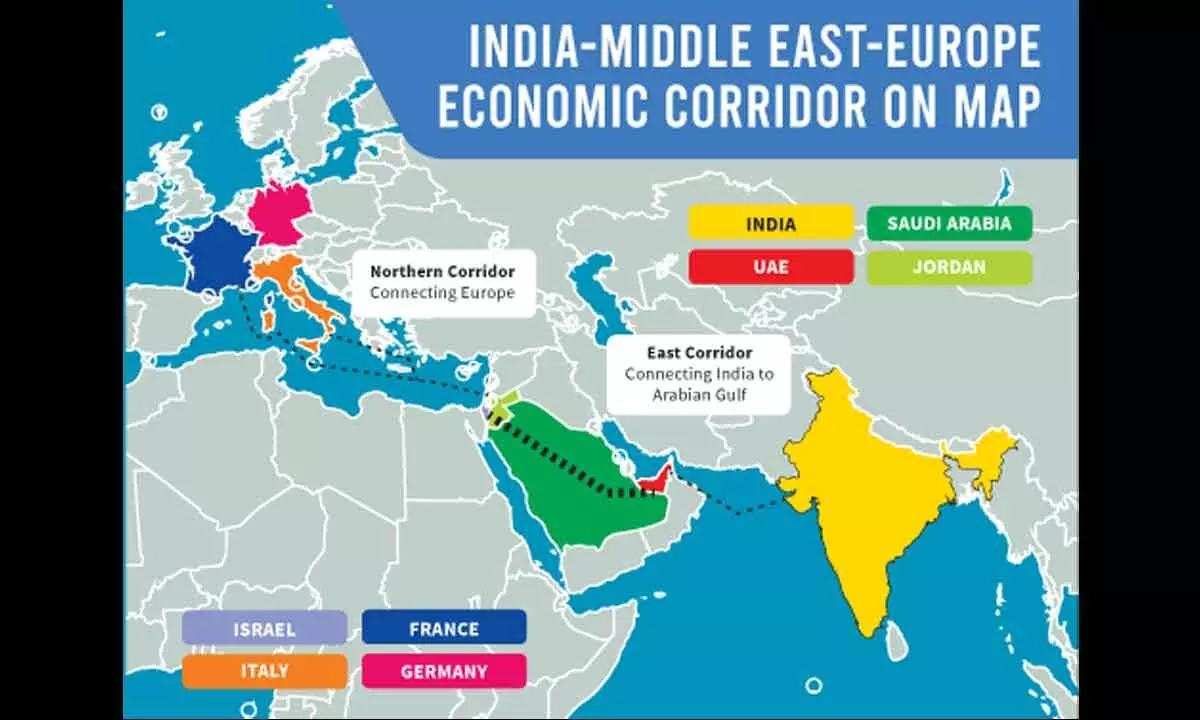
The IMEC to reshape global trade routes
Hans News Service | 30 Sept 2023 12:42 PM IST
Also to enhance geo-strategic balance & importance of India
Mostly misunderstood by many, IMEC is not to isolate China but is a challenge to Chinese BRI (Belt and Road Initiative). The foundation of this corridor as mentioned by PM Modi contradicts and rebuffs the framework of BRI. IMEC is not built on a framework that abandons any nation or situate them in debt. IMEC also gives Pakistan an option to review its sovereignty or continue paying a debt to China. India is formalizing and strengthening strategic allies with UAE and Saudi Arabia who will be pumping money in the corridor
Dhasmana: At the recently concluded G-20 Summit, PM Narender Modi along with other leaders finalized the most ambitious and largest investment and connectivity project for global economic growth – India-Middle East-Europe Corridor (IMEC). Under the Preamble of ‘One Planet, One Earth,’ he has envisaged this multi-model project of economics with global inclusivity. Unlike the not-so-successful BRI (Belt and Road Initiative) of China, the India- Middle East- Europe Economic Corridor is not country-specific but integrates Asia, Europe, and the Middle East. India, UAE, France, Germany, Italy, and the EU. This trade corridor will also involve other countries like Jordan, Israel, and Greece, and it bypasses Turkey.
The pivotal routes are: The east corridor connects India to the Arabian Gulf; 2. The northern corridor connecting the Arabian Gulf to Europe; 3. The Middle East Corridor consists of 2 separate corridors; and, 4. The East Corridor will link the Indian port of Mundra on the west coast to Fujairah port and then using the railroad via Saudi Arabia and Jordan transport goods through standardized containers to the Israeli port of Haifa.
Mostly misunderstood by many, IMEC is not to isolate China but is a challenge to Chinese BRI. The foundation of this corridor as mentioned by PM Modi contradicts and rebuffs the framework of BRI. IMEC is not built on a framework that abandons any nation or situate them in debt.
Potential Challenge
While we wait for the blueprint of the corridor, it is imperative to see the potential challenges that will need diplomatic interventions to stabilize geopolitical tensions for collective interest.
1. Whether it will be the Greek Port of Piraeus or Patras. Piraeus container berths are run by COSCO China. So, will there be some kind of co-existence as at HAIFA too the Chinese section is operational? If it is co-existence, then defining the Chinese role will be crucial.
2. The railway corridor will run from Saudi Arabia to Haifa port in Israel. The trade can be a forerunner in creating diplomatic relations, yet Saudi Arabia has yet to establish diplomatic ties with Israel.
3. The question of Israel. Riyadh has not yet mustered the courage to tie with Tel Aviv.
IMEC’s geopolitical significance to India
India under its “Act East Policy” is also well-focused on its North Eastern Region with all other countries and up to Vietnam. This unstated aspect of India deliberates on four connectivity projects to actively develop infrastructural projects in Northeastern India.
1. The Bay of Bengal Multi-Sectoral Technical and Economic (BIMSTEC), comprising Bangladesh, Bhutan, India, Myanmar, Nepal, Sri Lanka, and Thailand focuses on contiguous regional equality.
2. The Bangladesh-Bhutan-India and Nepal (BBIN) Motor Vehicle Agreement aims to facilitate the seamless flow of passenger, personal, and cargo vehicular traffic between and among the BBIN countries.
3. The Mekong- Ganga Cooperation (MGC) comprises India, Thailand, Myanmar, Cambodia, Laos, and Vietnam. This corridor aims at developing closer relations and better understanding among the member countries to enhance friendship, solidarity, and cooperation, facilitating inter-state movement and economic base within the region.
4. The Ayeyarwady-Chao Phraya-Mekong Economic Cooperation Strategy (ACMECS), comprising India, Cambodia, Lao PDR, Myanmar, Thailand, and Vietnam, aims to bridge the economic gap by utilizing member countries’ diverse strengths.
Southeast Asia has become India’s trading maritime frontier in the east. With the actualization of the IMEC, India will constitute an important hub of connectivity from the Southeast to Europe. Hence, it has a geostrategic significance for India.
Strategic Rebalancing
Growing China-Russia nexus, none of the countries of the West wishes to fight China. Europe has yet to handle Russia and they can’t think of building animosity with China. Eastern Land of India has challenges with Myanmar. This regime is unacceptable to the Western world which is relevant to the success of IMEC. IMEC also gives Pakistan an option to review its sovereignty or continue paying a debt to China. India is formalizing and strengthening strategic allies with UAE and Saudi Arabia who will be pumping money in the corridor.
Unlike the Chinese strategy of scattering money as an easy and not cheap debt in the global south, IMEC has the potential to create balance in the south. With AU joining G-20 making the forum G-21, it strengthens the representation of Global South. This was a pioneering step that had been initiated by PM Modi to drive global economic decisions. IMEC is an opportunity for economic balance in the International Order.
The interest of Gulf actors sees this corridor where they can strike their balance with China and the West for their own gains. Nevertheless, IMEC is considered to be a game-changer with India acting as a force to integrate these nations by adept diplomacy, and international collaboration to balance the economic and social voice of the geopolitics.